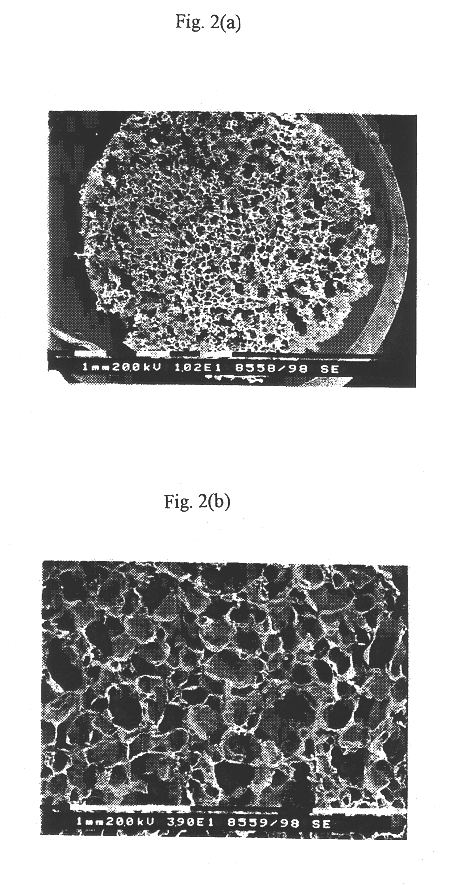Preparing porous biodegradable polymeric scaffolds for tissue engineering using effervescent salts
a biodegradable polymer and tissue engineering technology, applied in biochemistry apparatus and processes, enzymology, prosthesis, etc., can solve the problems of poor mechanical strength, limited application range, cell damage,
- Summary
- Abstract
- Description
- Claims
- Application Information
AI Technical Summary
Problems solved by technology
Method used
Image
Examples
example i
Preparation of Porous Scaffold from Poly(L-lactic Acid)
In methylene chloride was dissolved PLLA with a weight average molecular weight of 300,000 at a weight ratio of 1:6 PLLA:methylene chloride. The resulting polymeric solution was increased in viscosity by the evaporation of the solvent under the atmospheric pressure. To the concentrated polymeric solution, ammonium bicarbonate with a size distribution of 100-500 .mu.m was added at a mass ratio of 1:6 polymer:salt, followed by homogeneously mixing to yield a polymer / salt / solvent gel.
After being introduced into a brass mold which was 3 mm thick with a diameter of 25 mm, the gel was deprived of the solvent methylene chloride by evaporation under the atmospheric pressure. The polymer / salt mixture separated from the mold was desalted at a vacuum (9.times.10.sup.-6 Torr) for 14 days and then, submerged in distilled water of 40.degree. C. to completely leach out the remaining salt.
The salt-free polymeric scaffold thus obtained was dried...
example ii
Preparation of Porous Scaffold from Poly(L-lactic Acid)
In chloroform, PLLA with a weight average molecular weight of 300,000 was dissolved at a weight ratio of PLLA:chloroform ranging 1:10 to 1:20. To the resulting polymeric solutions of high viscosity, ammonium bicarbonate particles which had size distributions of 100-180 .mu.m, 180-300 .mu.m and 300-500 .mu.m, were added at mass ratios of 1:10, 1:15 and 1:20 polymer:salt, respectively, followed by homogeneously mixing to yield polymer / salt / solvent gels.
After being introduced into a Teflon mold which was 1.1 mm thick with a diameter of 5 mm, the gels each were deprived of the solvent methylene chloride by evaporation under the atmospheric pressure. The polymer / salt mixtures separated from the mold were submerged in 3 liters of distilled water maintained at 90.degree. C. to effervesce the salts to give polymeric scaffolds. The salt-free polymeric scaffolds thus obtained were dried in a vacuum drier.
Using a sputter (Hummers, techniqu...
example iii
Preparation of Porous Scaffold from Poly(D,L-lactic-co-glycolic Acid) through Polymeric Solution
In chloroform, poly(D,L-lactic-co-glycolic acid) (PLGA) 65 / 35 with a weight average molecular weight of 180,000 was dissolved at an amount of 30% by weight To the resulting polymeric solution of high viscosity, ammonium bicarbonate particles ranging, in size, from 180 to 300 .mu.m were added at mass ratios of 1:10, 1:15 and 1:20 polymer:salt, respectively, followed by homogeneously mixing to yield polymer / salt / solvent gels.
After being introduced into a Teflon mold which was 2 mm thick with a diameter of 5 mm, the gels each were deprived of the solvent methylene chloride by evaporation at the atmospheric pressure. Each of the polymer / salt mixtures separated from the mold was mixed to 3 liters of citric acid solutions of various concentrations (20%, 40%, 60%, supersaturated), and stirred to effervesce the salt. After completion of the effervescence, the porous polymeric scaffolds thus prepa...
PUM
| Property | Measurement | Unit |
|---|---|---|
| Fraction | aaaaa | aaaaa |
| Temperature | aaaaa | aaaaa |
| Temperature | aaaaa | aaaaa |
Abstract
Description
Claims
Application Information
 Login to View More
Login to View More - R&D
- Intellectual Property
- Life Sciences
- Materials
- Tech Scout
- Unparalleled Data Quality
- Higher Quality Content
- 60% Fewer Hallucinations
Browse by: Latest US Patents, China's latest patents, Technical Efficacy Thesaurus, Application Domain, Technology Topic, Popular Technical Reports.
© 2025 PatSnap. All rights reserved.Legal|Privacy policy|Modern Slavery Act Transparency Statement|Sitemap|About US| Contact US: help@patsnap.com



